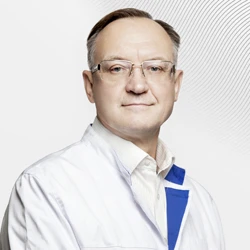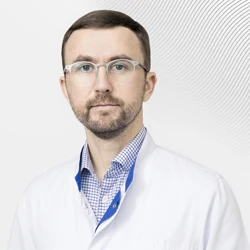Treatment of intervertebral hernia
Advantages of herniated disc treatment at the EMC Clinic



Causes of occurrence
The reason for the formation of intervertebral hernias is due to degenerative changes in cartilage tissue. Every person experiences such changes in the spine during the aging process. The formation of a hernia is also provoked by heavy physical exertion, lifting weights, injuries, falls, and professional sports.
Types of herniated discs
Herniated discs are classified according to their location – they form in the cervical, thoracic and lumbar spine.
Intervertebral hernia treatment
Treatment of a herniated disc always begins with conservative methods and lasts for 10-12 weeks from the onset of the disease. But there are two conditions under which a hernia removal operation is performed for emergency indications. Firstly, it is the presence of severe pain syndrome, due to which the patient cannot walk. Secondly, it is a condition in which a hernia presses on all nerve roots (horsetail lesion syndrome). A serious complication of this condition is a violation of the functions of the pelvic organs, so doctors immediately begin surgical treatment.
There are three types of surgical treatment for an intervertebral hernia: endoscopic, microsurgical, and advanced surgery with spinal implants.
Conservative hernia treatment
The course of conservative treatment of intervertebral hernia is carried out at the EMC Neurology Clinic. It includes physical therapy and physical therapy classes with a rehabilitologist, taking medications of various groups. The goal of conservative treatment is to strengthen the muscles of the back and create a natural muscular corset, which will relieve the load on the diseased intervertebral disc and reduce the degree of pressure on the nerve root.
If there is no significant effect from conservative treatment within 10-12 days (the nerve root is still compressed, the patient has pain in his leg or arm), then surgery is performed.
Endoscopic treatment
The EMC uses a modern method of endoscopic treatment of intervertebral hernias, which makes it possible to shorten the rehabilitation period. With this surgical treatment, one small puncture is made up to 1 cm wide, so minimal injury to the soft tissues of the spine occurs (surgeons do not cut the muscles, ligaments and tendons of certain muscles). This method also minimizes infection in the postoperative wound after hernia removal. The membrane of the nerve roots does not come into contact with air (oxygen is a strong oxidizing agent). With this treatment, the patient practically does not form cicatricial adhesions in the area of surgery. Within a few hours after the surgical treatment, the patient regains consciousness and the next day can go home and continue rehabilitation on an outpatient basis.Microsurgical treatment
Microsurgical method is the gold standard of treatment of intervertebral hernias worldwide. With this treatment, surgeons reach the spinal canal through a small incision, visualize the nerve root compressed by the hernia with a microscope, and remove it. The EMC operating rooms are equipped with an X-ray transparent operating table, a high-resolution microscope, and microsurgical instruments. Surgeons can also do an intraoperative X-ray. All this contributes to a high quality of treatment without complications after removal of herniated discs.Advanced surgery with implant placement
In the presence of herniated discs and instability of the vertebral motor segments, patients require advanced surgery. It includes the removal of most of the intervertebral disc, the herniation itself, and the release of the nerve root. At the end of the operation, surgeons install special fixing structures between the vertebrae in order to remove the pathological mobility of the intervertebral discs and stabilize the spinal-motor segment.
In the EMC clinic, this treatment method is performed through small skin incisions or punctures, using a microscope, minimally invasive technologies, and modern imported implants. With such treatment of a patient with a spinal hernia, the rehabilitation time is significantly reduced, which allows him to return to his usual life as soon as possible after surgery.
Symptoms
The symptoms of intervertebral hernias depend on their location. The pain syndrome is associated with the pressure of the hernia on the nerve roots. With a hernia in the lumbar spine, the patient experiences acute shooting pain in the leg, and with a hernia in the cervical spine, his arm hurts. This is often accompanied by pain and reflex syndromes in the corresponding parts of the spinal column. There may also be impaired motor functions (weakness in the leg or arm, paralysis of certain muscle groups and impaired sensitivity).
Diagnosis of intervertebral hernia
The main method of diagnosing herniated discs is magnetic resonance imaging (MRI). According to this study, doctors determine the presence of a morphological substrate of a herniated disc, the location and degree of its pressure on the nerve root. If necessary, the doctor may prescribe an X-ray with functional tests (X-ray in the position of maximum flexion and extension): This study makes it possible to exclude the instability of the vertebrae in intervertebral hernias.
If a patient with a hernia has pacemakers or metal foreign bodies in the body, then MRI is contraindicated in this case. In this case, computed tomography (CT) is performed to diagnose herniated discs. If this study is not enough, CT myelography is performed with the introduction of a radiopaque substance into the spinal canal, which contrasts the nerve roots during CT. As a result, the doctor sees more clearly the location of the hernia, which causes compression of the nerve roots.
Rehabilitation
- The duration of rehabilitation after surgery for spinal disc herniation depends on the patient's age and the presence of concomitant diseases.
- After endoscopic surgery, the patient can usually go home the next day and start classes with rehabilitation specialists and physical therapy instructors.
- A day after the removal of the herniated disc, the patient is verticalized and a phased rehabilitation begins.
- After microsurgery and advanced surgery with implant placement, longer rehabilitation is required, which can be performed in a specialized EMC Rehabilitation Center in Zhukovka.
Why the EMC
The first and only clinic in Russia, created in the image of the world's leading clinics
EMC is a multidisciplinary center offering patients a high level of medical services and a personalized approach
Worldwide recognition and awards
 Learn more
Learn more
Worldwide recognition and awards
 Certificates and licenses
Certificates and licenses
Make an appointment for a consultation
Specify your contacts and we will contact you to clarify the details
Reviews
and new products of the EMC



